RocketMQ 生产者
这篇文章,我们从源码的角度探寻 RocketMQ Producer 的实现机制。

1 基础配置
我们先展示生产者发送消息的示例代码。
// 1. 初始化默认生产者,传递参数生产者组名
DefaultMQProducer producer = new DefaultMQProducer(PRODUCER_GROUP);
// 2. 设置名字服务地址
producer.setNamesrvAddr("name-server1-ip:9876;name-server2-ip:9876");
// 3. 启动生产者服务
producer.start();
// 4. 定义消息对象
Message msg = new Message(*TOPIC* /* Topic */,
*TAG* /* Tag */,
("Hello RocketMQ " + i).getBytes(RemotingHelper.*DEFAULT_CHARSET*) /* Message body */
);
msg.setKeys("");
// 5. 发送消息
// 示例普通消息
SendResult sendResult = producer.send(msg);
// 示例异步回调
producer.send(msg, new SendCallback() {
@Override
public void onSuccess(SendResult sendResult) {
// do something
}
@Override
public void onException(Throwable e) {
// do something
}
});
// 示例oneway发送
producer.sendOneway(msg);
发送流程如下:
- 初始化默认生产者,传递参数生产者组名;
- 设置名字服务地址 ;
- 启动生产者服务;
- 定义消息对象 ;
- 生产者支持普通发送、oneway 发送、异步回调三种方式发送消息 。
2 发送消息流程
2.1 构造函数
下图展示了生产者DefaultMQProducer 类的构造函数,包装类 DefaultMQProducerImpl 是我们这一小节的核心。
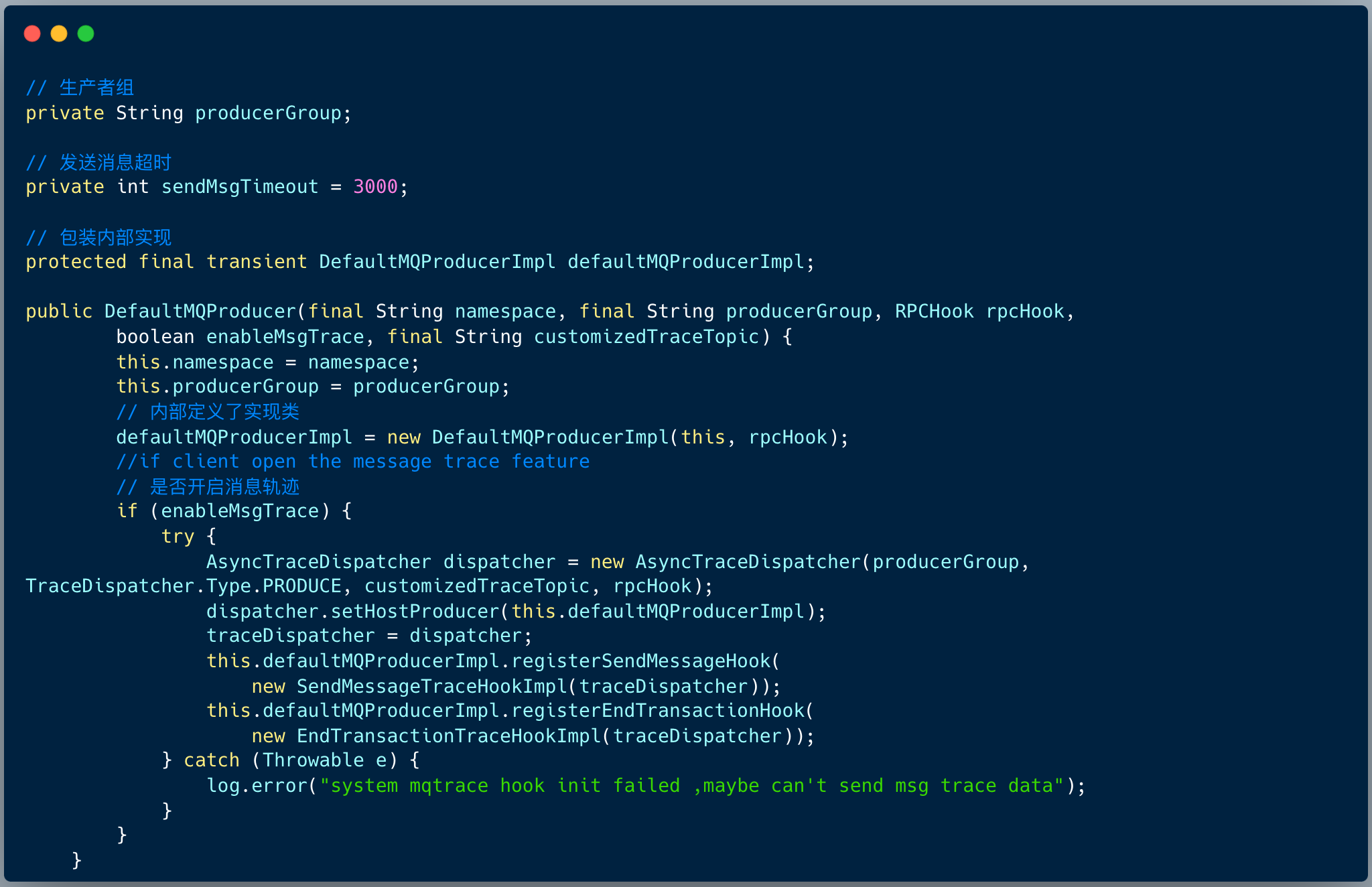
构造函数包含两个部分:
初始化实现类 DefaultMQProducerImpl ;
根据是否开启消息轨迹参数
enableMsgTrace判断是否增加消息轨迹逻辑 。
2.2 启动生产者
DefaultMQProducer 类的 start 方法,本质上是调用包装类 DefaultMQProducerImpl 的 start 方法。
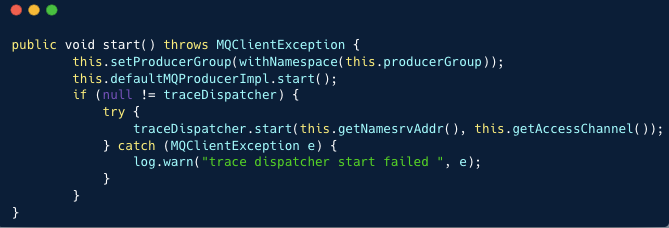
进入 DefaultMQProducerImpl 类,查看该类的逻辑 。
01 检测配置
判断生产者组是否合法,生产者名称不能和默认生产者组名称相同。

02 创建客户端实例

MQClientInstance 对象通过 MQClientManager 这个单例类创建 ,标志着一个客户端实例,是非常核心的类,每一个实例对象有一个唯一的 clientId。
- 生产者表/消费者表引用

路由信息

03 注册本地生产者
boolean registerOK = mQClientFactory.registerProducer(this.defaultMQProducer.getProducerGroup(), this);
注册本地生产者的本质是修改客户端实例的生产者表引用:
MQProducerInner prev = this.producerTable.putIfAbsent(group, producer);
04 启动客户端实例
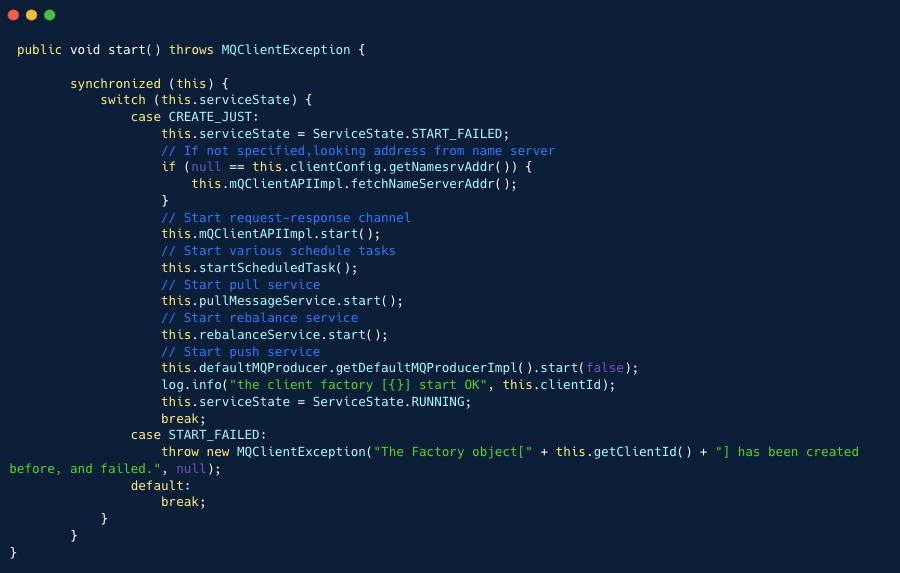
实例启动后,会启动通讯模块、定时任务、负载均衡服务、消费者拉取服务。
下图展示了生产者发送消息时,IDEA 里的线程 DUMP 图:

我们需要重点讲讲定时任务 startScheduledTask方法 , 定时任务如下图:

我们重点关注发送心跳和更新路由两个任务。
- 发送心跳: 定时任务每隔 30 秒将客户端信息发送到 Broker 。

当 Broker 收到心跳请求之后,会通过生产者管理器 ProducerManager、消费者管理器ConsumerManager分别更新生产者客户端缓存、消费者客户端缓存。
- 更新路由
对于生产者来讲,它需要知道需要发送消息的主题对应的路由信息 , 因此需要定时更新路由信息。
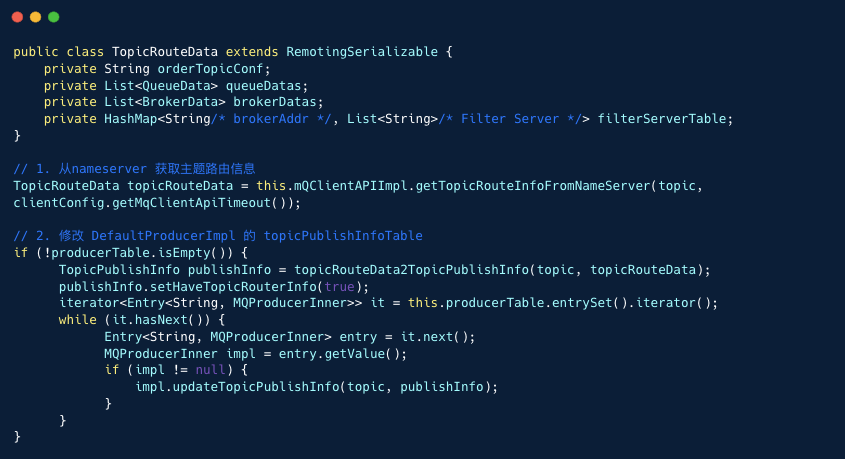
更新逻辑比较简单,首先从名字服务获取主题路由信息对象 topicRoute,然后更新 DefaultMQProducerImpl的主题发布信息topicPublishInfoTable对象 。
2.3 发送消息
进入 DefaultMQProducerImpl 类,查看发送消息方法 sendDefaultImpl 。
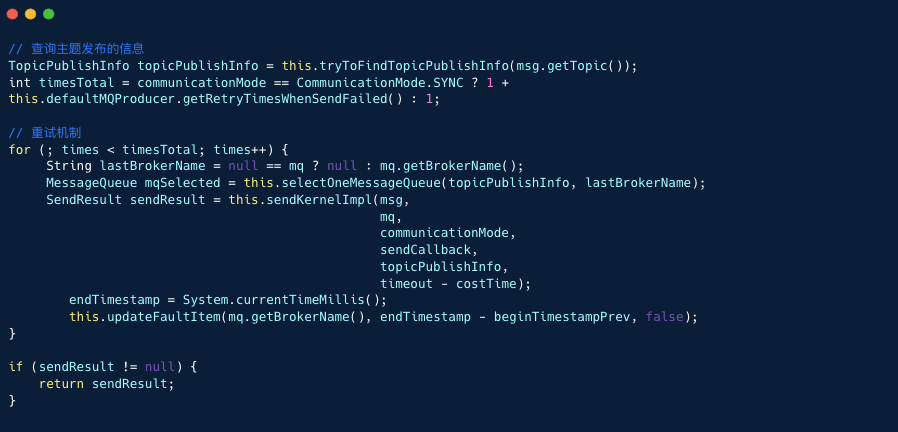
笔者将发送消息流程简化如下:
获取主题发布信息;
根据路由算法选择一个消息队列,也就是
selectOneMessageQueue方法;调用
sendKernelImpl发放消息对象,封装成发送结果对象sendResult。
01 尝试获取主题发布信息
我们知道 MQClientInstance 的定时任务每隔30秒会更新生产者实现类的topicPublishInfoTable ,但若第一次发送消息时,若缓存中无数据时候,还是要重新拉取一次。

02 根据路由算法选择一个消息队列
RocketMQ 存储模型包含三部分: 数据文件 commitlog 、消费文件 consumequeue 、索引文件 indexfile。


因此根据 RocketMQ 的存储模型设计,**对于生产者来讲,发送消息时,必须指定该主题对应的队列。**路由算法,我们会在路由机制这一节重点讲解。
MessageQueue mqSelected = this.selectOneMessageQueue(topicPublishInfo, lastBrokerName);
03 调用实例客户端 API 发送消息
通过路由机制选择一个 messageQueue 之后,调用实例客户端 API 发送消息。

Broker 端在收到发送消息请求后,调用处理器 SendMessageProcessor处理请求,处理完成后,将响应结果返回给生产者客户端,客户端将接收到的数据组装成 SendResult对象。
3 路由机制
进入DefaultMQProducerImpl#selectOneMessageQueue 方法:
public MessageQueue selectOneMessageQueue(final TopicPublishInfo tpInfo, final String lastBrokerName) {
return this.mqFaultStrategy.selectOneMessageQueue(tpInfo, lastBrokerName);
}
路由机制通过调用 MQFaultStrategy 的 selectOneMessageQueue 方法 ,这里有一个 sendLatencyFaultEnable 开关变量,默认为 false 。
public class MQFaultStrategy {
//省略部分代码 日志
private final LatencyFaultTolerance<String> latencyFaultTolerance = new LatencyFaultToleranceImpl();
private boolean sendLatencyFaultEnable = false;
private long[] latencyMax = {50L, 100L, 550L, 1000L, 2000L, 3000L, 15000L};
private long[] notAvailableDuration = {0L, 0L, 30000L, 60000L, 120000L, 180000L, 600000L};
//省略部分代码 get/set方法
public MessageQueue selectOneMessageQueue(final TopicPublishInfo tpInfo, final String lastBrokerName) {
// 发送延迟错误策略
if (this.sendLatencyFaultEnable) {
try {
int index = tpInfo.getSendWhichQueue().incrementAndGet();
for (int i = 0; i < tpInfo.getMessageQueueList().size(); i++) {
int pos = Math.abs(index++) % tpInfo.getMessageQueueList().size();
if (pos < 0)
pos = 0;
MessageQueue mq = tpInfo.getMessageQueueList().get(pos);
if (latencyFaultTolerance.isAvailable(mq.getBrokerName()))
return mq;
}
final String notBestBroker = latencyFaultTolerance.pickOneAtLeast();
int writeQueueNums = tpInfo.getQueueIdByBroker(notBestBroker);
if (writeQueueNums > 0) {
final MessageQueue mq = tpInfo.selectOneMessageQueue();
if (notBestBroker != null) {
mq.setBrokerName(notBestBroker);
mq.setQueueId(tpInfo.getSendWhichQueue().incrementAndGet() % writeQueueNums);
}
return mq;
} else {
latencyFaultTolerance.remove(notBestBroker);
}
} catch (Exception e) {
log.error("Error occurred when selecting message queue", e);
}
return tpInfo.selectOneMessageQueue();
}
// 默认策略
return tpInfo.selectOneMessageQueue(lastBrokerName);
}
public void updateFaultItem(final String brokerName, final long currentLatency, boolean isolation) {
if (this.sendLatencyFaultEnable) {
long duration = computeNotAvailableDuration(isolation ? 30000 : currentLatency);
this.latencyFaultTolerance.updateFaultItem(brokerName, currentLatency, duration);
}
}
private long computeNotAvailableDuration(final long currentLatency) {
for (int i = latencyMax.length - 1; i >= 0; i--) {
if (currentLatency >= latencyMax[i])
return this.notAvailableDuration[i];
}
return 0;
}
}
这里有两个逻辑分支 :
sendLatencyFaultEnable为 false , 通过TopicPublishInfo中的messageQueueList中选择一个队列(MessageQueue)进行发送消息 ;sendLatencyFaultEnable为 true ,开启延迟容错机制。
3.1 默认机制
// TopicPublishInfo 类
public MessageQueue selectOneMessageQueue(final String lastBrokerName) {
if (lastBrokerName == null) {
return selectOneMessageQueue();
} else {
for (int i = 0; i < this.messageQueueList.size(); i++) {
int index = this.sendWhichQueue.incrementAndGet();
int pos = Math.abs(index) % this.messageQueueList.size();
if (pos < 0)
pos = 0;
MessageQueue mq = this.messageQueueList.get(pos);
if (!mq.getBrokerName().equals(lastBrokerName)) {
return mq;
}
}
return selectOneMessageQueue();
}
}
public MessageQueue selectOneMessageQueue() {
int index = this.sendWhichQueue.incrementAndGet();
int pos = Math.abs(index) % this.messageQueueList.size();
if (pos < 0)
pos = 0;
return this.messageQueueList.get(pos);
}
默认机制有两个要点:
- 循环遍历该主题下所有的队列 ;
- 若上一个失败的 Broker 参数值存在,需要过滤掉上一个失败的 Broker 。
3.2 延迟容错机制
所谓延迟容错机制,是指发送消息时,若某个队列对应的 Broker 宕机了,在默认机制下很可能下一次选择的队列还是在已经宕机的 broker ,没有办法规避故障的broker,因此消息发送很可能会再次失败,重试发送造成了不必要的性能损失。
因此 producer 提供了延迟容错机制来规避故障的 Broker 。
当 sendLatencyFaultEnable 开关为 true 时,在随机递增取模的基础上,代码逻辑会再去过滤掉 not available 的 Broker 。
if (latencyFaultTolerance.isAvailable(mq.getBrokerName()))
return mq;
所谓的" latencyFaultTolerance ",是指对之前失败的,按一定的时间做退避。
例如,如果上次请求的latency超过 550Lms,就退避 3000Lms;超过1000L,就退避 60000L ;如果关闭,采用随机递增取模的方式选择一个队列(MessageQueue)来发送消息,latencyFaultTolerance 机制是实现消息发送高可用的核心关键所在。
sendResult = this.sendKernelImpl(msg, mq, communicationMode, sendCallback, topicPublishInfo, timeout - costTime);
endTimestamp = System.currentTimeMillis();
this.updateFaultItem(mq.getBrokerName(), endTimestamp - beginTimestampPrev, false);
发送消息时捕捉到异常同样会调用 updateFaultItem 方法:
endTimestamp = System.currentTimeMillis();
this.updateFaultItem(mq.getBrokerName(), endTimestamp - beginTimestampPrev, true);
endTimestamp - beginTimestampPrev等于消息发送耗时,如果成功发送第三个参数传的是 false ,发送失败传 true。
继续查看 MQFaultStrategy#updateFaultItem 源码:
public void updateFaultItem(final String brokerName, final long currentLatency, boolean isolation) {
if (this.sendLatencyFaultEnable) {
long duration = computeNotAvailableDuration(isolation ? 30000 : currentLatency);
this.latencyFaultTolerance.updateFaultItem(brokerName, currentLatency, duration);
}
}
private long computeNotAvailableDuration(final long currentLatency) {
for (int i = latencyMax.length - 1; i >= 0; i--) {
if (currentLatency >= latencyMax[i])
return this.notAvailableDuration[i];
}
return 0;
}
computeNotAvailableDuration方法会判断当前消息发送耗时,位于哪一个延迟级别,然后选择对应的 duration 。
private long[] latencyMax = {50L, 100L, 550L, 1000L, 2000L, 3000L, 15000L};
private long[] notAvailableDuration = {0L, 0L, 30000L, 60000L, 120000L, 180000L, 600000L};
如果 isolation 为 true,该 broker 会得到一个10分钟规避时长 ,也就是 600000L 毫秒 。
如果 isolation 为 false,假设 currentLatency 为 600L , 那么规避时间 30000L 毫秒。
查看 LatencyFaultToleranceImpl#updateFaultItem 源码:
public void updateFaultItem(final String name, final long currentLatency, final long notAvailableDuration) {
// 从缓存中获取失败条目
FaultItem old = this.faultItemTable.get(name);
if (null == old) {
//若缓存中没有,则创建
final FaultItem faultItem = new FaultItem(name);
faultItem.setCurrentLatency(currentLatency);
// broker的开始可用时间=当前时间+规避时长
faultItem.setStartTimestamp(System.currentTimeMillis() + notAvailableDuration);
old = this.faultItemTable.putIfAbsent(name, faultItem);
if (old != null) {
old.setCurrentLatency(currentLatency);
old.setStartTimestamp(System.currentTimeMillis() + notAvailableDuration);
}
} else {
// 更新旧的失败条目
old.setCurrentLatency(currentLatency);
old.setStartTimestamp(System.currentTimeMillis() + notAvailableDuration);
}
}
FaultItem 为存储故障 broker 的类,称为失败条目,每个条目存储了 broker 的名称、消息发送延迟时长、故障规避开始时间。
该方法主要是对失败条目的一些更新操作,如果失败条目已存在,那么更新失败条目,如果失败条目不存在,那么新建失败条目,其中失败条目的startTimestamp为当前系统时间加上规避时长, startTimestamp 是判断 broker 是否可用的时间值:
public boolean isAvailable() {
return (System.currentTimeMillis() - startTimestamp) >= 0;
}
4 顺序消息
顺序消息可以保证消息的消费顺序和发送的顺序一致,即先发送的先消费,后发送的后消费,常用于金融证券、电商业务等对消息指令顺序有严格要求的场景。
4.1 如何保证顺序消息
消息的顺序需要由以下三个阶段保证:
消息发送
如上图所示,A1、B1、A2、A3、B2、B3 是订单 A 和订单 B 的消息产生的顺序,业务上要求同一订单的消息保持顺序,例如订单A的消息发送和消费都按照 A1、A2、A3 的顺序。
如果是普通消息,订单A的消息可能会被轮询发送到不同的队列中,不同队列的消息将无法保持顺序,而顺序消息发送时 RocketMQ 支持将 Sharding Key 相同(例如同一订单号)的消息序路由到一个队列中。
RocketMQ 版服务端判定消息产生的顺序性是参照同一生产者发送消息的时序。不同生产者、不同线程并发产生的消息,云消息队列 RocketMQ 版服务端无法判定消息的先后顺序。

消息存储
顺序消息的 Topic 中,每个逻辑队列对应一个物理队列,当消息按照顺序发送到 Topic 中的逻辑队列时,每个分区的消息将按照同样的顺序存储到对应的物理队列中。
对于 kafka 来讲,1个主题会有多个分区,数据存储在每个分区,分区里文件以
Segment文件串联起来。对于 RocketMQ 来讲 , 存储模型包含三部分: 数据文件 commitlog 、消费文件 consumequeue 、索引文件 indexfile。
kafka 和 RocketMQ 文件模型很类似,只不过 kafka 的文件数据都会存储在不同的分区里,而 RocketMQ 的数据都存储在 CommitLog 文件里 ,不同的消息会存储在不同的消费队列文件里,便于提升消费者性能(索引)。
所以我们只需要将特定的消息发送到特定的逻辑队列里,对于 kafka 来讲是分区 partition ,对于 RocketMQ 来讲,就是消费队列 messageQueue 。
消息消费
RocketMQ 按照存储的顺序将消息投递给 Consumer,Consumer 收到消息后也不对消息顺序做任何处理,按照接收到的顺序进行消费。
Consumer 消费消息时,同一 Sharding Key 的消息使用单线程消费,保证消息消费顺序和存储顺序一致,最终实现消费顺序和发布顺序的一致。
4.2. 生产者发送顺序消息
下面的代码展示生产者如何发生顺序消息 。
DefaultMQProducer producer = new DefaultMQProducer("please_rename_unique_group_name");
producer.start();
String[] tags = new String[] {"TagA", "TagB", "TagC", "TagD", "TagE"};
for (int i = 0; i < 100; i++) {
int orderId = i % 10;
Message msg =
new Message("TopicTestjjj", tags[i % tags.length], "KEY" + i,
("Hello RocketMQ " + i).getBytes(RemotingHelper.DEFAULT_CHARSET));
SendResult sendResult = producer.send(msg, new MessageQueueSelector() {
@Override
public MessageQueue select(List<MessageQueue> mqs, Message msg, Object arg) {
Integer id = (Integer) arg;
int index = id % mqs.size();
return mqs.get(index);
}
}, orderId);
System.out.printf("%s%n", sendResult);
}
producer.shutdown();
发送顺序消息需要定制队列选择器 MessageQueueSelector。
SendResult send(final Message msg, final MessageQueueSelector selector, final Object arg)
throws MQClientException, RemotingException, MQBrokerException, InterruptedException;
public interface MessageQueueSelector {
MessageQueue select(final List<MessageQueue> mqs, final Message msg, final Object arg);
}
进入 DefaultMQProducerImpl#sendSelectImpl , 查看顺序消费发送的实现逻辑。
private SendResult sendSelectImpl(
Message msg,
MessageQueueSelector selector,
Object arg,
final CommunicationMode communicationMode,
final SendCallback sendCallback, final long timeout
) throws MQClientException, RemotingException, MQBrokerException, InterruptedException {
// 省略代码
TopicPublishInfo topicPublishInfo = this.tryToFindTopicPublishInfo(msg.getTopic());
if (topicPublishInfo != null && topicPublishInfo.ok()) {
MessageQueue mq = null;
try {
List<MessageQueue> messageQueueList =
mQClientFactory.getMQAdminImpl().parsePublishMessageQueues(topicPublishInfo.getMessageQueueList());
Message userMessage = MessageAccessor.cloneMessage(msg);
String userTopic = NamespaceUtil.withoutNamespace(userMessage.getTopic(), mQClientFactory.getClientConfig().getNamespace());
userMessage.setTopic(userTopic);
// 调用 selector 的select 方法,传递相关参数,选择某一个队列
mq = mQClientFactory.getClientConfig().queueWithNamespace(selector.select(messageQueueList, userMessage, arg));
} catch (Throwable e) {
throw new MQClientException("select message queue threw exception.", e);
}
long costTime = System.currentTimeMillis() - beginStartTime;
if (timeout < costTime) {
throw new RemotingTooMuchRequestException("sendSelectImpl call timeout");
}
if (mq != null) {
return this.sendKernelImpl(msg, mq, communicationMode, sendCallback, null, timeout - costTime);
} else {
throw new MQClientException("select message queue return null.", null);
}
}
validateNameServerSetting();
throw new MQClientException("No route info for this topic, " + msg.getTopic(), null);
}
从上面的顺序消息发送代码,我们得到两点结论:
- 顺序消息发送时,需要实现
MessageQueueSelector的select方法 ; - 发送顺序消息时,若发送失败没有重试。
参考文档:
https://developer.aliyun.com/article/918025
